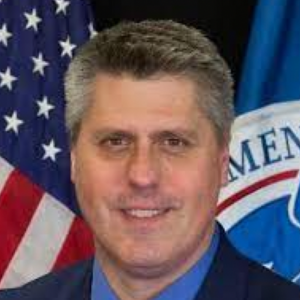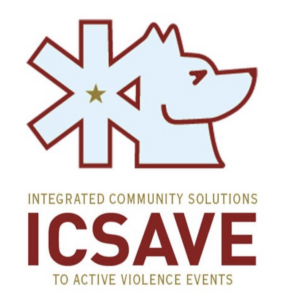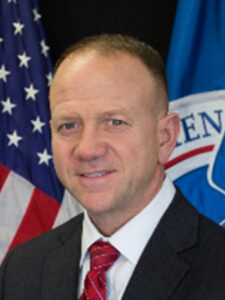Homeland Security Today’s annual Holiday Hero Awards honor those who have made lasting contributions to our nation’s security and risen to meet myriad challenges, recognizing those who have dedicated their careers to making our nation safer within the homeland security enterprise and those who have used their talents, determination, or platform to contribute to a safer country.
Here are the winners in the border security and customs and immigration field. (Read the full list of HSToday Award winners and Mission Award winners.)
HOMELAND SECURITY PERSON OF THE YEAR
The GTSC Homeland Security Today Person of the Year is awarded to people who serve the homeland security mission in an exemplary fashion. These individuals have directly improved, executed, and/or engaged the proper people, agencies, or departments necessary to tangibly improve the nation’s prevention, protection, mitigation, or response capacity to make America safer.
PERSON OF THE YEAR: LOCAL
Sergeant Michael Satter, Deputy Director, Kansas City Regional Fusion Center, Kansas City Missouri Police Department
 His promotion of the regional fusion center and capacity building of private stakeholders in the greater Kansas City metropolitan area led to his selection as the co-chair of the National Network of Fusion Centers’ Private Sector Engagement Committee. There he continues to grow private-sector partnerships with state and regional fusion centers, while also facilitating the improved communications and information sharing of the committee with the Office of the Director of National Intelligence, the Federal Bureau of Investigation, the Domestic Security Alliance Council, the Department of Homeland Security’s Private Sector Office, and the National Council of Information Sharing and Analysis Centers.
His promotion of the regional fusion center and capacity building of private stakeholders in the greater Kansas City metropolitan area led to his selection as the co-chair of the National Network of Fusion Centers’ Private Sector Engagement Committee. There he continues to grow private-sector partnerships with state and regional fusion centers, while also facilitating the improved communications and information sharing of the committee with the Office of the Director of National Intelligence, the Federal Bureau of Investigation, the Domestic Security Alliance Council, the Department of Homeland Security’s Private Sector Office, and the National Council of Information Sharing and Analysis Centers.
His leadership and persistence to improve private-sector outreach helped lead to his selection as a member of the National Fusion Center Association’s Executive Board and an April 2022 appointment as co-chair for the Central Region, where he directly represents 16 of the 80 fusion centers in the national network. In 2022, Satter delivered multiple educational presentations at the federal, local, and private partnership levels. He served as a keynote presenter and trainer at the National Fusion Center Association Annual Training Event and the National Homeland Security Conference to educate and share best practices for improving information sharing and educational initiatives for private-sector partners to improve threat reporting and assessment. Satter took the lead to engage with private, local, state, and federal agencies to capture accurate regional data. He helped review the analysis on, and syntheses of, information that led to Kansas City’s metropolitan area being awarded the federal designation as an Urban Area Security Initiative (UASI) city in 2022. Satter is a recognized principal contributor for protection and resiliency planning in the multi-state (Missouri and Kansas) region. He served on several regional committees such as the Mid-America Regional Council’s Regional Homeland Security Coordinating Committee, including key participation on regional terrorism and bio/agriculture meetings to facilitate private and public understanding of threats, risks, and consequences. His insights were instrumental in these committees developing threat mitigation strategies and plans. Satter skillfully championed outreach and engagements with large private-sector lifeline critical infrastructure organizations in the region. Through his outreach, Satter facilitated discussion, planning, and information sharing that enhanced the protection level and resiliency of these large private organizations. He served as the lead municipal anti-terror outreach coordinator with the siting and security development of the future largest data center in the U.S. owned by Meta. He provided key outreach and collaboration between Kansas City and private stakeholders to include the NFL for the 2023 NFL Draft. He facilitated private, local, and federal engagement, outreach and information sharing with critical infrastructure stakeholders such as Evergy energy and AT&T communications.
Satter’s contributions in the discipline of outreach and engagements comprehensively improved the information sharing, training, and education capacities of all he has interacted with at federal, state, local, and private partner agencies and organizations. His contributions indicate his professionalism, commitment, and tireless efforts to improve community safety, protection, and resiliency.
MOST INNOVATIVE CAMPAIGN TO INCREASE SECURITY
People around the nation are working to find creative and engaging ways to help the public understand and prepare for any eventuality. Educating the public about homeland priorities, threats, and vulnerabilities is a critical part of the security equation. The Most Innovative Campaign to Improve Security recognizes a federal, state, local, or private-sector campaign that has increased awareness and preparedness for a threat that requires the partnerships to mitigate and prevent physical or cyber attack, disaster preparedness, human trafficking, infrastructure protection, supply-chain security or any threat to the country.
Department of Homeland Security Office for Bombing Prevention: Douglas DeLancey, Strategy Branch Chief

Douglas DeLancey is Strategy Branch Chief at Office for Bombing Prevention, where the Bomb-Making Materials Awareness Program (BMAP) represents one of the best ways to detect and report suspicious purchasing behaviors in the U.S. A key program of the Cybersecurity and Infrastructure Security Agency’s OBP, BMAP informs and educates retailers and the public about recognizing bomb-making materials, suspicious purchasing behaviors, and the reporting of suspicious activity.
The BMAP team led efforts in 2022 for CISA to collaborate with the FBI on Operation Flashpoint, a joint campaign between CISA and the FBI to build awareness in communities across the U.S. for preventing bomb attacks. The initiative aims to encourage businesses and the public to voluntarily report suspicious activities, such as buying large amounts, or a combination of, chemicals and materials that can be used to build bombs. Currently, approximately 250,000 businesses across the nation sell or distribute everyday materials that can be used for deadly purposes. Bomb-making materials are readily available at beauty supply stores, hardware stores, pool supply stores, sporting goods stores, home centers, and elsewhere.
Domestic violent extremism is on the rise across the U.S., and extremists increasingly plot and attack using improvised explosive devices (IEDs). Terrorists, criminals, and others often build IEDs from common household items using instructions found on the internet. Bad actors can easily purchase enough of certain chemicals and other materials that are readily available in stores to build home-made explosives. Programs that encourage voluntary reporting of suspicious activity can help avert future incidents involving such IEDs.
The Operation Flashpoint campaign has two main goals:
1. Build awareness – Reducing the threat of IED attacks by restricting access to explosive precursor chemicals (EPCs). This means helping businesses detect the illegitimate acquisition, theft, or diversion of EPCs at the retail level.
2. Encourage suspicious activity reporting – Providing businesses with training and guidance to report suspicious activity to police, consistent with the National Suspicious Activity Reporting Initiative (NSI); and encourage reporting to the FBI’s tipline for the Weapons of Mass Destruction Directorate at 1-855-CALL-FBI (1-855-835-5324).
The BMAP team has spearheaded wide-ranging campaign efforts to highlight the dangers of EPCs. For instance, the team conducted more than 8,000 outreach efforts to make point-of-sale retailers aware of EPCs. The team also developed videos and Spanish-language materials to make diverse audiences aware of bomb-making materials, threats and resources.
BMAP’s outreach team has worked with FBI Weapons of Mass Destruction Coordinators, CISA’s Field Force, representatives from CISA’s Office for Bombing Prevention, and its state, local, tribal, and territorial partners on Operation Flashpoint. BMAP visits businesses and community leaders, providing training and outreach materials. During 2022, BMAP and the FBI held numerous awareness events that featured media, legislators, retailers and many others in locations including Orlando, Fla., Fort Collins, Colo., and Phoenix, Ariz. Concurrently, the BMAP team conducted a marketing campaign that reached 700,000 businesses through an e-mailing and mailing campaign. The BMAP team utilized a database of open-source information on businesses that sell or stock explosive precursor chemicals and bomb-making materials.
From “mom and pop” hardware outlets to big-box retailers, citizens and businesses throughout the country play a key role in helping prevent a potential bombing attack, since the bomber can use chemicals and materials readily available in stores. Bomb attacks are a significant threat: In 2021, the U.S. Bomb Data Center reported 1,876 bomb threats, 4,935 suspicious or unattended packages, and 381 bombing-related incidents across the U.S. Recognizing these threats early can help law enforcement take action to try to prevent attacks. Operation Flashpoint helps store owners, managers, and employees spot suspicious activities related to bomb making. As the eyes and ears in this community, residents and business owners alike can learn what to look out for and when to alert law enforcement to large purchases of potentially dangerous chemicals or combinations of items used in homemade explosives.
CITIZEN OF MISSION
The Citizen of Mission award goes to an individual who devotes their personal time, energy, and resources to work for causes related to homeland security. Volunteers, nonprofit leaders, corporate employees — anyone is eligible for nomination as long as they devote time and dedicated effort to supporting the homeland mission.
RC Smith, Board Member, INLETS
 The Citizen of Mission is awarded to someone who has volunteered their time and service in support of the homeland security mission. So after the last decade of a distinguished career in physical security, crisis management and counterintelligence, Homeland Security Today is extremely pleased to present RC Smith with the Citizen of Mission award.
The Citizen of Mission is awarded to someone who has volunteered their time and service in support of the homeland security mission. So after the last decade of a distinguished career in physical security, crisis management and counterintelligence, Homeland Security Today is extremely pleased to present RC Smith with the Citizen of Mission award.
A member of the volunteer-run InfraGard since 2011, he joined the Maryland chapter board of directors where he furthered the collaborative information sharing between DHS and other federal agencies by designing and hosting meetings at LM sites. He started a defense industrial base (DIB) working group in protected space where the competitors could gather and share threat concerns while facilitating the FBI and other intel agencies to share threat updates to the specific industry. He attended and graduated from the FBI Citizens Academy and serves as a member of the Baltimore chapter’s Alumni Association. There he has maintained and furthered relationships with industries with similar threat challenges and furthered discussion on resolutions.
Additionally, Smith has helped plan and deliver the INLETS training since 2013. INLETS is a nonprofit created to support law enforcement investigators and analysts with leading-edge training on the most relevant topics by the most experienced individuals possible. There, he serves on the INLETS board of directors and chairs the benefactor program, which he designed to recognize and reward those who serve our communities.
Through all these official positions, Smith is also a noted pen turner. In that quiet role, he humbly designs unique, handcrafted, one-of-a-kind writing instruments for individuals who serve our country or support those who do. For instance, his pens have been requested by organizations who presented them as tokens of appreciation to Col. Oliver North and Gary “Lt. Dan” Sinise. In his own principled way, he has never sold a pen for profit but rather as a personal gift to individuals with a servant’s heart.
In his “day jobs,” Smith became a U.S. Marine shortly after graduating high school. He served a 21-year career with distinction throughout the Pacific and then as the Senior Enlisted for Guantanamo Bay, Cuba. Once entering civilian life, he joined Lockheed Martin where for 25 years he has served in physical security, crisis management and counterintelligence roles at multiple facilities in the DMV. For over 45 years he has led, facilitated, and protected defenders of our nation.
For his 45 years of supporting the national security mission abroad and at home, as a U.S. Marine and as a defense contractor, in designing substantive training programs, and creating unique gifts of appreciation, RC Smith is a Citizen of Mission. He has lived his life in “Oscar Mike” fashion. That military phonetic alphabet stands for “On Mission.” And if you know RC, that is the way he lives — with focus, purpose, and intention.
ORGANIZATION OF MISSION
Integrated Community Solutions to Active Violence Events (ICSAVE)
 Integrated Community Solutions to Active Violence Events (ICSAVE) is an Arizona-based charitable foundation created by volunteer professionals from throughout the state who are united by their dedication to the prevention of traumatic events through education, preparedness training and community outreach programs.
Integrated Community Solutions to Active Violence Events (ICSAVE) is an Arizona-based charitable foundation created by volunteer professionals from throughout the state who are united by their dedication to the prevention of traumatic events through education, preparedness training and community outreach programs.
Living and working within their respective communities, they actively strive to develop integrated preparedness and response practices and strategies to prevent or mitigate the physical, psychological, spiritual and financial impact of incidents ranging in severity from common workplace and recreational injuries to violent mass casualty incidents. To date, they have provided lifesaving education to over 160,000 Arizonans.
EXCELLENCE IN OUTREACH
Much of partnership requires knowledge and understanding. Communication between industry and government to achieve the best products and services requires outreach in all stages: requirements building, request for information, effective industry days, outreach through engagement and much more. The Excellence in Outreach award recognizes the agency, department, or individual that has excelled at engaging, explaining and educating to benefit the mission of securing the nation.
FEDERAL
Curtis Tilley, Branch Chief, Office for Bombing Prevention, Cybersecurity and Infrastructure Security Agency

Branch Chief Curtis Tilley at the Department of Homeland Security’s Office for Bombing Prevention, within the Cybersecurity and Infrastructure Security Agency, consistently displays the agency’s core values of honesty, professionalism, and public service. He understands the importance of building connections, developing relationships and collaboration to drive smarter, more insightful engagements with national and international public safety organizations and security professionals. Tilley was instrumental in the federal government’s response to bomb threats that targeted Historically Black Colleges and Universities (HBCU). He developed a communication strategy and outreach plan to provide just-in-time products specifically for HBCUs. He led the effort to develop a suite of resources to assist universities in responding to bomb threats, including critical resources for handling bomb threats that provide an overview of available resources, a bomb threat response plan template, bomb threat awareness, and a tabletop exercise package. This was followed by numerous training events for HBCUs in face-to-face and virtual deliveries.
Tilley’s innovative strategies were key in the office’s international engagements with Canada, Mexico, Romania, and the United Nations to help build counter-IED core capabilities and enhance awareness of terrorist threats. This strategy called for a shared approach to security in which the partnering countries work together to address threats to critical infrastructure and citizenry. He led the office’s outreach efforts with Public Safety Canada and the Royal Canadian Mounted Police in the Beyond the Border initiative to enhance understanding of the bomb threat environment and share information and training products to help enhance cross-border critical infrastructure protection and resilience. Tilley, in cooperation with the Department of State’s Export Control and Related Border Security (EXBS) Program, led the international collaboration efforts with the Mexican government to share bombing prevention practices and awareness training products. The benefits of the yearlong outreach effort were realized when the Office for Bombing Prevention delivered training to members of the Mexican Secretariat of the Navy, Secretariat of Defense, Ministry of Security and Citizen Protection, Federal Protective Service and the National Coordination of Civil Protection. Tilley was instrumental in the office’s efforts to protect life and critical infrastructure by building capabilities within the general public and across the public and private sectors to prevent, protect against, respond to, and mitigate bombing incidents. The OBP Training Branch under his leadership recently reached a milestone of training its 150,000th person in bombing prevention.
EXCELLENCE IN EDUCATION AND TRAINING
This award recognizes an organization’s exceptional efforts in building partnerships and capacity for entities to be able to better detect, prevent and respond to a range of threats.
INLETS
 The purpose of the Intel & Law Enforcement Training Services organization is the definition of the acronym: Just as an inlet connects large oceans to smaller bays, rivers, and tributaries, the INLETS connects large law enforcement agencies to the smaller agencies and organizations and, together, all are made more effective. Over the past 11 years, INLETS has collaborated with the private sector and all levels of law enforcement to provide the most relevant training by experienced instructors at the most affordable registration cost for attendees. Based in Annapolis, Md., it was created in 2011 by four FBI agents who responded to the Pentagon and the World Trade Center on 9/11. They were tasked with creating a training program for state and local law enforcement in matters of violent crime and terrorism. To develop a holistic approach, they partnered with the Maryland state fusion center and with local InfraGard chapters. The intentional design and triangular approach allowed for the greatest impact, benefit, and collaboration. They use the strengths of each element: the FBI has connection to subject matter experts, the state has connection to the local jurisdictions, and InfraGard has connection to the private-sector practitioners and supporting partners.
The purpose of the Intel & Law Enforcement Training Services organization is the definition of the acronym: Just as an inlet connects large oceans to smaller bays, rivers, and tributaries, the INLETS connects large law enforcement agencies to the smaller agencies and organizations and, together, all are made more effective. Over the past 11 years, INLETS has collaborated with the private sector and all levels of law enforcement to provide the most relevant training by experienced instructors at the most affordable registration cost for attendees. Based in Annapolis, Md., it was created in 2011 by four FBI agents who responded to the Pentagon and the World Trade Center on 9/11. They were tasked with creating a training program for state and local law enforcement in matters of violent crime and terrorism. To develop a holistic approach, they partnered with the Maryland state fusion center and with local InfraGard chapters. The intentional design and triangular approach allowed for the greatest impact, benefit, and collaboration. They use the strengths of each element: the FBI has connection to subject matter experts, the state has connection to the local jurisdictions, and InfraGard has connection to the private-sector practitioners and supporting partners.

Using this model, the team has created agendas that are equally important to both the private and public sectors. INLETS has reached over 10,000 attendees from more than 1,000 agencies and companies, over 20 InfraGard chapters, 30 state fusion centers, and 40 institutions of higher education from 47 states and seven countries. A one-day program on active shooters was requested through the private sector including faith-based organizations, schools, and retail companies. While among the most common topics offered by hundreds of entities, this agenda averages 150 attendees from 100 entities and companies traveling from seven states for the one-day program. Similarly, the team offers a one-day program on cyber-based financial institution fraud. With an average of 120 attendees traveling from the four largest financial institution markets, they learn from law enforcement and industry experts on the current and emerging threats. After the onset of the pandemic, the team identified and worked with an academic partner to use these same presenters in webinar programs (INLETS Online) so that the attendees could safely maintain their professional development while complying with health department and company policies. And in the past two years, the team has focused on returning to traditional training platforms.
The five-day program (2021-22) is regarded as the best violent crime and terrorism training available. Referred to as “an experience, not a training,” the program averages 9.3 out of 10 with 175 attendees from 100 agencies across 15 states in three time zones. It is mandatory training for a number of police agencies. In 2023, it heads to New Orleans for its third visit. Newly added focused training includes a 4-day agenda specifically on homicide investigations (2021, 2022) with a 9.7 survey evaluation. Using that same format, new for 2023 are investigative social media and tech resources and another on behavioral threat assessment. With the academic partner, these programs are also being evaluated for academic credit in addition to CEUs. Through 2022, INLETS has been collaborating on expanding the training aspect of the program to include investigative support. And INLETS is developing a platform to support law enforcement with cold case consultations and investigative genealogy set for late 2023. This team, made up of federal, state, and private-sector colleagues, has been afforded great opportunity to successfully support, collaborate, and train attendees from the federal, state, and private-sector communities.
MISSION AWARDS
Each year, Homeland Security Today honors shining stars in the community who are making their own unique, invaluable contributions to advance the mission of keeping America safer from myriad threats. Their strong commitment to mission touches every part of their work, from day-to-day operations to special projects and work in the community.
Sean Haglund, Associate Director, Department of Homeland Security Office of Bombing Prevention
 Sean Haglund led the Office for Bombing Prevention (OBP), part of the Department of Homeland Security’s Cybersecurity and Infrastructure Security Agency (CISA), through a tumultuous year to overcome major infrastructure security challenges. In 2022, OBP Associate Director Haglund spearheaded the office’s efforts to implement the National Policy for Countering Improvised Explosive Devices (IEDs), the policy that guides our nation to secure the U.S., its allies, partners and interests against IEDs. His leadership has helped the U.S. better prevent, protect against, respond to, and mitigate the use of explosives against critical infrastructure, the private sector, and federal, state, local, tribal, and territorial entities.
Sean Haglund led the Office for Bombing Prevention (OBP), part of the Department of Homeland Security’s Cybersecurity and Infrastructure Security Agency (CISA), through a tumultuous year to overcome major infrastructure security challenges. In 2022, OBP Associate Director Haglund spearheaded the office’s efforts to implement the National Policy for Countering Improvised Explosive Devices (IEDs), the policy that guides our nation to secure the U.S., its allies, partners and interests against IEDs. His leadership has helped the U.S. better prevent, protect against, respond to, and mitigate the use of explosives against critical infrastructure, the private sector, and federal, state, local, tribal, and territorial entities.
Haglund skillfully led OBP in 2022 during a time of significant security concerns that included an exponential spike in bomb threats targeting Historically Black Colleges and Universities (HBCUs). More than 30 of the 101 HBCUs received 49 bomb threats in January and February alone. Haglund demonstrated exceptional leadership, creativity, and collaboration while leading the office to develop and implement mitigations to counter the threat and increase resilience. Haglund led the team to assess the threat landscape, coordinate response efforts, host training seminars, tailor products and resources to schools, and provide key capacity-building and preparedness assistance to stakeholders.
More specifically, Haglund led OBP efforts to respond to the threats against HBCUs by:
- Helping lead a bomb threat forum with the Atlanta University Center Consortium, a nonprofit operating on behalf of Clark Atlanta University, Morehouse College, Morehouse School of Medicine, and Spelman College. It is the world’s oldest and largest association of HBCUs. The discussion provided critical guidance for managing bomb threats while keeping students, facility, and staff safe from harm.
- Testifying before the U.S. House Committee on Oversight and Reform about OBP’s ability to respond to emerging threats, including providing a vast array of resources that help prevent bomb attacks
- Overseeing the delivery of 27 courses that trained 1,253 people
- Developing a bomb threat plan template for universities, a mass bomb threat awareness job aid, and co-developing a CISA tabletop exercise package
- Publishing a bulletin (called the TRIPwire Awareness Bulletin) that explains how to respond to mass bomb threat campaigns
Haglund drove strategy for a wide range of free, innovative, capacity-building programs that now serve as the prototype for how to prevent, protect against, respond to, and mitigate the use of explosives. For instance, he oversaw OBP’s Counter-IED Training and Awareness effort — a range of internationally accredited trainings in multiple formats delivered to participants from the public, major corporations, and high-profile agencies at all levels of government. OBP trained 18,000 people this year alone, bringing the total number of people OBP has now trained to 150,000 — a remarkable achievement.
Additionally, Haglund helped spearhead the growth of the Bomb-Making Materials Awareness Program, which is laser-focused on preventing IED attacks early, when adversaries try to acquire the necessary materials. This included collaborating closely with the FBI on Operation Flashpoint, an initiative that raises awareness among retailers across the U.S. of the dangers of domestic violent extremists and others purchasing explosive precursor chemicals from stores. The impact: Retailers and people across the nation now know about Operation Flashpoint, including the 8 million people who watched a segment about it on NBC Nightly News with Lester Holt earlier this year. Such efforts have led more people to report suspicious activity that can be connected to bombs.
Haglund also led strategic efforts in many other areas. This included development of OBP’s Annual Operating Plan, which guided the office’s activities to increase capacity, speed delivery, use innovation and improve performance. Additionally, in 2022, he helped lead a rewrite of Presidential Policy Directive 17 (PPD-17): Countering IEDs, the policy that guides our nation to counter IEDs and secure the U.S., its allies, partners and interests from IEDs.
Haglund has been the driving force behind OBP’s key efforts to increase preparedness, reduce risk, and ultimately save lives and make the U.S. a more secure country.
Shawn McDonald, Program Manager, Counter-Unmanned Aircraft Systems (C-UAS), Department of Homeland Security Science and Technology Directorate
 Shawn McDonald is the Counter-Unmanned Aircraft Systems (C-UAS) program manager at the Department of Homeland Security’s Science and Technology Directorate, within the Mission and Capability Support Office. In this role he is tasked with assessing C-UAS technologies both in laboratory and real-world operational environments and assisting DHS components in developing and refining requirements, completing the congressionally mandated 6 USC 124n process to test and evaluate prototype C-UAS capabilities at a covered asset or mission, and in executing limited-duration C-UAS technology pilots at DHS component locations. The program also guides the development of new and innovative technologies to deliver critical C-UAS capabilities to DHS components.
Shawn McDonald is the Counter-Unmanned Aircraft Systems (C-UAS) program manager at the Department of Homeland Security’s Science and Technology Directorate, within the Mission and Capability Support Office. In this role he is tasked with assessing C-UAS technologies both in laboratory and real-world operational environments and assisting DHS components in developing and refining requirements, completing the congressionally mandated 6 USC 124n process to test and evaluate prototype C-UAS capabilities at a covered asset or mission, and in executing limited-duration C-UAS technology pilots at DHS component locations. The program also guides the development of new and innovative technologies to deliver critical C-UAS capabilities to DHS components.
With the threat capabilities of UAS rapidly advancing around the globe, McDonald’s work — and particularly his effective program leadership — are at the forefront of the homeland security enterprise rising to meet this challenge. McDonald and his team execute their tasking within a whole-of- government structure, chaired by DHS, to meet C-UAS threats as granted via the Preventing Emerging Threats Act of 2018. This act protects designated covered facilities or assets across both DHS and Department of Justice missions and provides authorities from detecting through ultimately seizing and destroying UAS threats. He leads his team in executing these responsibilities by conducting rapid and agile research, development, test and evaluation of continuously evolving C-UAS technologies against similarly rapidly evolving UAS technologies.
The team Shawn has assembled to execute this work include not only his S&T program staff, but also a wide assortment of federal and state government laboratories, research centers, and functional office stakeholders, public and private university research facilities, and best-in-class, vendor-agnostic industry partners. Since 2018, McDonald’s team has been responsible for rapidly identifying and deploying initial C-UAS capability to critical field locations and other covered assets, such as a USCG operational site, a port of entry along the southern U.S. border, and a site within the national capital region. They have identified, assessed, and transitioned prototype C-UAS capabilities to the FPS and USCG. And they have established a U.S.-wide prototype drone detection network to enable C-UAS-authorized DHS Component operators to view and analyze near-real-time drone detection data. Beginning this year, McDonald’s team is transitioning additional C-UAS pilot capabilities to DHS components for operational use, as well as initiating development and modernization of advanced multi-modal detection technologies to help the entire homeland security enterprise maintain pace with small UAS threats.






